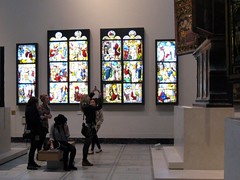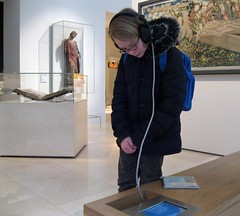I remember that when I started working in museums in the late 1990s, computer terminals and audio points were just starting to become common sights in gallery displays. Often, there was a film running on a loop on a television screen, or there was a somewhat clunky computer supplying limited information. The question of whether or not to include tools like this within displays was extremely divisive, with many curators and visitors bitterly opposed to the idea, on the quite reasonable grounds that they distracted from the wonderful objects on show, and that they were ugly.
When the V&A opened its British Galleries in 2000, it was the first major suite in the Museum to make extensive use of such tools. The experience offered in the British Galleries was, for me at least, a good one; we’d taken the trouble to provide the technology in ways that were particularly useful, informative, or stimulating. A good example is the demonstration of William Burges’s wash-stand, an object that for conservation reasons can’t be regularly used, but for which a film was made, demonstrating the elegant and clever means by which water was dispensed into the wash bowl, and then emptied out into a cistern. If you’re interested in Burges’s washstand, then follow this link: http://www.vam.ac.uk/collections/furniture/videos/washstand/modem.html
For the Medieval & Renaissance Galleries, we followed the same path. The aim was to keep the quality of the content high, but to make sure that the means of delivery was discreet and did not in any way detract from the beauty of the objects we were displaying. We thought very carefully about the placement of every screen – close enough to have an obvious relationship with the relevant object, but not so close as to overwhelm it. However, we were very aware that technology was developing faster than we could keep pace with it.
In the first year of our planning, 2002, I remember being shown what the Getty Museum in Los Angeles was developing for their galleries – a portable mini-computer that visitors borrowed from the Entrance Desk, which would provide you with information and films about selected objects in the collection. At the time, I thought this was hugely ambitious, and quite futuristic!
 Of course, by the time our galleries opened in 2010, there had been a revolution in the amount of computing power being carried around in many of our visitors’ pockets. When I first watched Steve Jobs’s launch presentation of the iPhone, it was obvious that this device was going to revolutionise the way people lived their lives. And already since then, visitors now expect to be able to use WiFi to go online in the Museum, and to be able to access more and more information about the collections on the internet.
Of course, by the time our galleries opened in 2010, there had been a revolution in the amount of computing power being carried around in many of our visitors’ pockets. When I first watched Steve Jobs’s launch presentation of the iPhone, it was obvious that this device was going to revolutionise the way people lived their lives. And already since then, visitors now expect to be able to use WiFi to go online in the Museum, and to be able to access more and more information about the collections on the internet.
Our online output these days is starting to resemble that of a small tv company, with the Museum’s own video ‘channel’, and films often presented by well-known figures like Howard Goodall or David Dimbleby. As far as the Medieval & Renaissance Galleries go, we were aware enough of the direction in which things were moving to make sure that all the gallery films, audios and computer interactives were made available on our website as well as within the Museum.
Which brings me to my point – over the last couple of months, we’ve been planning a new step towards our provision of information using technology. In the next few weeks, the Museum will launch an App for iPhone, iPad and Android phones, specifically about the Medieval & Renaissance Galleries. Users will have access to a series of highlight objects with text and photos, the text and photos from the introduction to the accompanying book, and a series of audios including tours of the galleries. I’m particularly excited about the tours, because if you’re anything like me, then you’ll know that it can be very hard to absorb a lot of information via text panels in museums. On the other hand, if you’re shown around by somebody who knows the objects well, it’s always a more vital and stimulating experience. I do a lot of tours of the spaces, but by offering one of my tours this way, far more people will be able to benefit. We’ll also be able to keep updating the content (offering new tours, for example) over time.
Of course, we can’t expect our visitors to come armed with an iPhone. That’s why labels and wall panels will never be replaced in museums. But many visitors do own these devices, and increasingly, we’ll be able to offer them great ways of improving the experience of their visit. It also means that we don’t have to loan out devices, that there is no added clutter within the galleries, and that visitors are more in control of their own visit. All of which have to be good things!
It would be great to know about other innovative museum interpretation you’ve come across. Feel free to post below…

It’s rather a trendy and also handy bit of details. We are thankful that you simply shared this beneficial facts around. Remember to keep us up to date similar to this. Appreciate expressing.